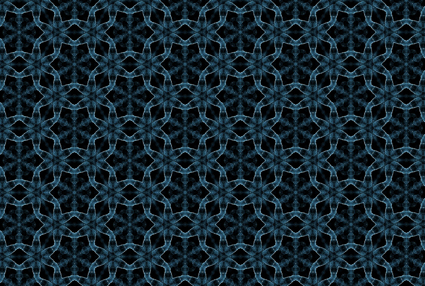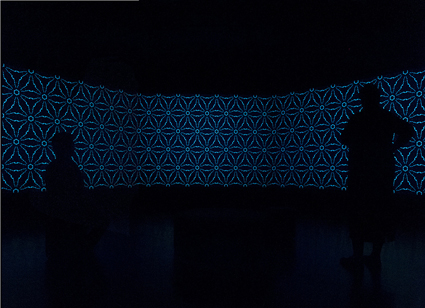Telepathic dreaming & the art of mind
Laetitia Wilson: Karen Casey, Dream Zone

Dream Zone, digital compilation from screen, Karen Casey
courtesy the artist and Anna Pappas Gallery
Dream Zone, digital compilation from screen, Karen Casey
“Technology-based art has well and truly cemented itself in the cultural milieu,” writes hybrid artist Karen Casey. Aboriginal artists working with media technologies today create works that present a marriage of tradition and technology, a collusion of past and future in terms of techniques and aesthetic appearance. This was made clear back in 1984, when the first remote Aboriginal television broadcast came out of Yuendumu, 300km north-west of Alice Springs.
In the background of this broadcast was a painting by Andrew Japaljarri Spencer. Titled Satellite Dreaming (1984), it has a central planetary sphere out of which pathways branch to other spheres. It represents the desire for access to communications and broadcast technology, and specifically television, for remote communities. It is a visual picturing of how old media works, with a centralised hub that broadcasts content outward and it is seen on the very medium it pictures, yet it is created using ochre and paint, in dot style with symbolic iconography.
Jumping forward 30 years to another celestially-themed image, a lithographic print by Karen Casey becomes the content for a projection artwork created using technology at vast removes from analogue television. The print is titled Nebula, the current artwork, Dream Zone. Nebula became the visual data fed into a program for creating imagery using Casey’s brain waves. Dream Zone communicates different intentions from those of the Warlpiri in Yuendumu with their television broadcasts, yet it shares the same spirit in its desire to connect with others, in the quest for shared experience.
In 2004 Casey approached the Brain Sciences Institute at Swinburne University with the vision of getting data from her brain to use for the creation of artwork. At the same time she met her now key collaborator Harry Sokol. Since then Casey has created a series of works under the umbrella title of Global Mind Project, looking “at the idea, the possibility, the probability of the interconnected mind beyond the individual.” While originally from a painting and printmaking background, Casey maintains that in moving into media arts her ideas have remained consistent, but as she writes “digital technology has completely expanded my creative repertoire and given me the means to produce interactive and generative spaces and experiences that I was previously not able to realise.”
Dream Zone is a three-channel projection featuring an array of morphing, hexagonal-shaped mandalic forms. Like a soft breath the forms gently pulse in and out, all the while undulating in a seemingly infinitely complex and varied pattern to a background of ethereal music. Despite visual complexity the pattern is minimal, fading to black at times and leaving the viewer immersed in darkness for brief moments, until crystalline forms pierce through like star formations drawn from mysterious faraway galaxies. The colour palette ranges from inky blacks to icy blues and whites and, together with the forms, it appears as much at home among the minutiae of tropical waters as it does meandering through the cosmos.

Karen Casey, Dream Zone, 2012, Generative video installation, National New Media Art Award, Queensland Art Gallery/Gallery of Modern Art, Brisbane. 2012
photo Ben Wickes
Karen Casey, Dream Zone, 2012, Generative video installation, National New Media Art Award, Queensland Art Gallery/Gallery of Modern Art, Brisbane. 2012
The Dreaming is so fundamental to Indigenous cosmology and art that I had to ask if this understanding had relevance for Dream Zone. Casey conceded to some relationship in that she proposes the possibility of “an association between an individual’s experience, or dreaming if you like, and that of others within the wider community.” More directly however, Casey’s use of the term ‘dream’ refers neurologically to theta brainwaves. “Theta waves are at the lower end of the frequency spectrum and when predominant they can be associated with dream states, creative improvisation and inspirational thought processes.” When viewed within the broader context of Aboriginal Dreaming Casey believes there is a relationship to theta mind-states. She writes, “It is in those instances when you totally lose yourself in the moment that you can transcend the temporal experience and access a kind of timeless continuum.” Indigenous temporality is ambiguous, ever-present and repeatable, as against historical time, which is linear, unrepeatable and future orientated. Sitting and watching Dream Zone is like being momentarily transported to a state of atemporality, beyond the task-driven noise of the everyday.
Neurologically, if the experience of art creates a pleasurable zing in the brain, it is triggered by a synergy of sensual relations between you and a given thing/object. Dream Zone is created via feedback with Casey’s own brain. She meditated on the morphing hexagon kaleidoscope while her brain waves were recorded and fed back into the program—she created the electroencephalographic feed for the work while she experienced it live. Ideally, the resulting imagery would stimulate a theta state in the viewer, “I anticipate viewers will experience a deeply meditative or trance-like state.” It is very enjoyable and relaxing to be in the presence of this work: staring into it does effect perception and takes you somewhere else. It is also quietly spiritual, on the topic of which Casey states, “…anything that can engender a feeling of connection with the world or make you feel like there is no difference between self and other sets the stage for what I think of as spiritual—there’s an empathy that comes out of that space but also a sense that the whole thing is dependent on consciousness. The consciousness I’m referring to is the interconnected totality of existence rather than simply an autonomous product of our physical being.”
Where else will this project be taken? How far will Casey push the question of the power of the collective mind and how much will she push the capabilities of the technology with her collaborator Sokol? The software developed by Sokol has a mind-boggling amount of aesthetic potential and there is certainly scope for the project to have more conceptual punch. Casey works from an “holistic perspective on life—of creativity, connection and community” and although Dream Zone trades heavily on the experiential, her background features strong projects with a social focus. By her own account Casey envisages an online scenario “where you can actually log in and have a neural conversation with someone else or a group of people.” However elusive it might be, the artistic potential of telepathy is a logical culmination of this exploration of the art of mind.
Dream Zone, generative video installation, artist Karen Casey, technical collaborator, software interface designer Harry Sokol, sound recording, compilation Tim Cole, media compositor, systems designer James Power; Fremantle Arts Centre, 23 Nov, 2013- 19 Jan, 2014
RealTime issue #119 Feb-March 2014 pg. 52






